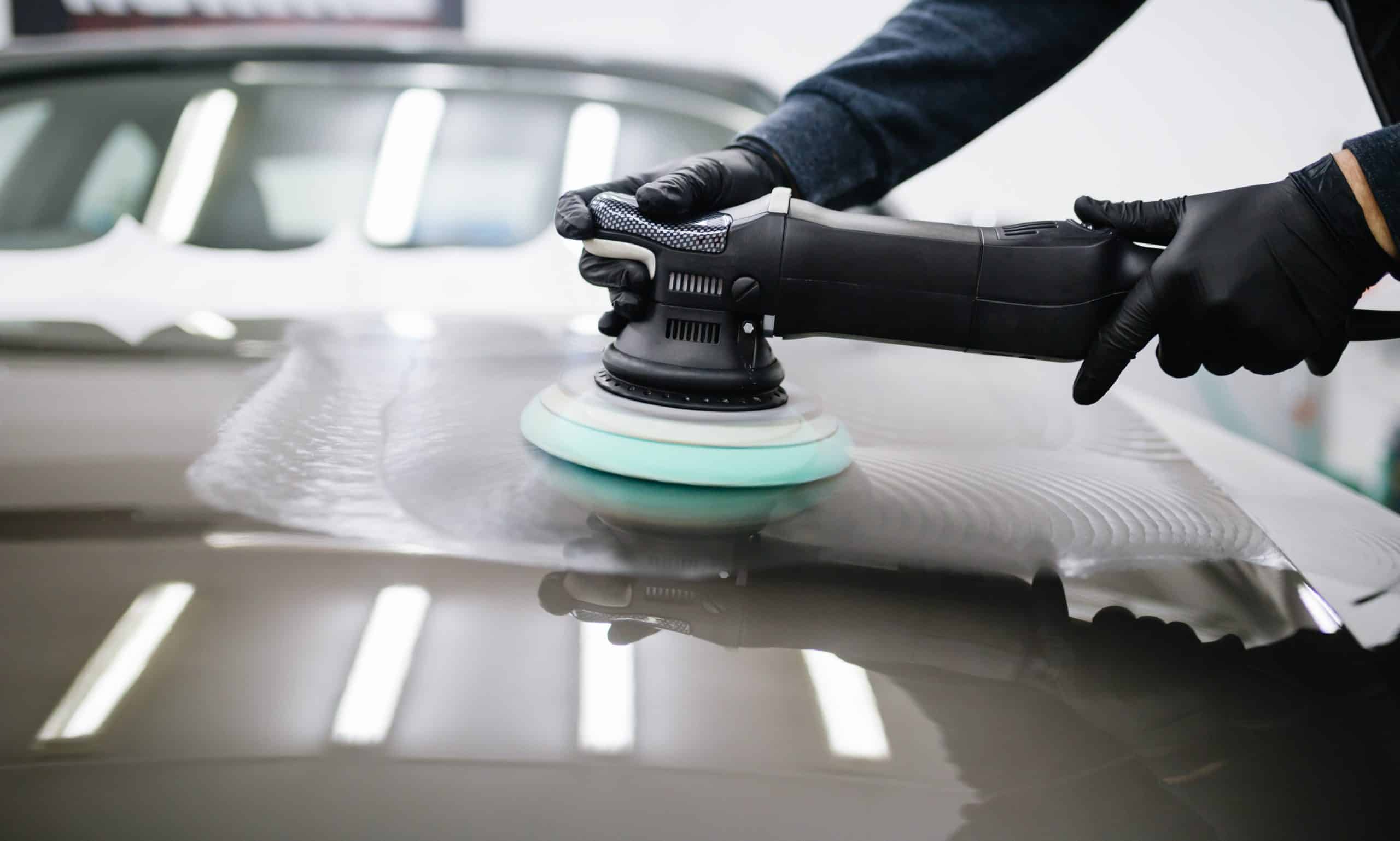
If you know how to, your wheels and tires aren’t as hard to clean as you would think.
With the right tools, an efficient technique and the most effective products, you’re set up for success!
Grime and dust builds up on your car’s wheels and tires over time, making them hard to clean.
Though this dirt may look like ordinary dust it is certainly not. Most of the brown-blackish soot is actually a chemical mix of iron from your brake discs or drums, dust from your calipers and a combination of other chemical residue from road splash.
This chemical cocktail is baked on by the heat generated by your brakes, friction heat from your tires and the sun.
To make matters (aesthetically) worse, car tires become brownish, some faster than others.
This phenomenon called “blooming” is caused by antiozonants, tire rubber components added by tire manufacturers to slow rubber aging and deterioration because of ozone and oxygen.
Of course you could use aggressive chemicals to effortlessly remove this grime and tire blooming, but these harsh chemicals would also damage your wheel coating, deteriorate your tire rubber and even cause corrosion.
Not to mention that they would be very harmful for your health and the environment too.
The ideal solution is to use carefully balanced, specialized products that neutralize acids and dissolve all dirt and blooming so they can gently be brushed and rinsed off without harming your wheels and tires.
Check out our other posts for more information on dedicated wheel and tire cleaners and wheel and tire brushes. We’ve tried and tested the most effective ones in a comprehensive review.
Now let’s get to the point. Here’s how to clean your wheels and tires like a professional detailer:
How To Clean Wheels and Tires like a Professional Detailer
Preparation
1. Park your car in the shade
Parking your car in the shade before you wash your wheels and tires is important for several reasons:
- The heat of full sunlight will soften your wheels’ clear coat making them more vulnerable to scratching during the washing process. So, make sure they’re cool before you start washing them.
- The sun’s direct heat will dry your soapy water before you have the chance to rinse and dry your wheels, which will leave hard-to-remove soap- and water marks.
- Cleaning wheels and tires is the first step in the car wash process, so it will save you time parking your car in the right spot from the start, so you won’t have to move your stuff around when you’re in full momentum.
Also, check that your disc brakes are cool if you’ve just driven your car. Spraying cold water on hot brake discs may warp them.
If you have no shade on your street or driveway, it’s best to wash your wheels and tires on a cloudy day, early in the morning or late in the evening.
However, in late autumn or early spring the sun is too weak to heat up your wheels, so you should be OK. Cautiously touch the wheel surface before you start, to make sure it isn’t hot. Use common sense.
2. Everything you need to clean your wheels and tires
- tire brush, wheel brush, wheel woolie(s)
- car wash bucket, grit guard, washboard
- pressure washer, 25° pressure washer nozzle
- wheel and tire cleaner
- budget microfiber towels
- fender brush (for off-road vehicles)
- air compressor (optional)
- car air dryer (optional)
Here’s how to wash your wheels and tires in 7 easy steps
Step 1: Pressure-wash your wheels, tires and fenders
First blast the inside of your fenders, wheels and tires with your pressure washer set between 1200 and 1900 PSI. Higher pressure might damage your wheel paint.
Using a 25° nozzle for wheels and tires works best to blast away this notoriously stubborn brake dust and caked up mud. It enhances pressure to get that nasty brake dust and road grime off your wheels and tires, the dirtiest parts of your vehicle.
Don’t hold the nozzle closer than a foot away from your wheels, again to prevent damaging them.
In our opinion, thoroughly pressure-washing your inside wheel fenders is sufficient, but you can also clean ‘em with a long handle fender brush and wheel and tire cleaner.
This type of brush is hard on dirt but soft on paint and can reach the deepest wheel arches.
If you own an SUV or ATV that you use off-road or on muddy roads, we do think a fender brush is a must-have.
Note: If you’re cleaning a classic car, never blast away at it with a pressure washer or even a hose with a high pressure jet, tempting as it may seem. You will blow water in cracks and crevices where it normally can’t get. And can’t get out of…
Over time, this trapped water will cause rust and rot.
For a classic car, only use a soft water jet and try to avoid getting water in places that are rust-prone like cracked paint, crevices and openings.
Step 2: Spray wheel and tire cleaner
Spray your wheels and tires with wheel and tire cleaner. Let it work for a couple of minutes but don’t let it dry.
Some products are designed to clean both wheels and tires, some are formulated very specifically for one or the other.
Check out our favorite wheel and tire cleaners for the best in our test.
Step 3: Scrub your tires
Thoroughly scrub the sidewalls of your tires with your tire brush. It has coarser hair than a wheel brush to be able to remove all that sticky brown gunk from the rubber tire face.
Be careful not to brush over the wheel edges. These hard bristles may scratch delicate wheel coatings.
After having scrubbed a tire, always thoroughly rinse your tire brush in a car wash bucket with tap water before scrubbing the next tire.
If your tire brush is really dirty, you can rub it over your bucket’s washboard to work loose even the toughest grime. Dirt and grit will get trapped underneath the grit guard where it can’t soil any brushes during their rinsing process.
Step 4: Clean your wheel faces
Next clean your car’s wheel faces with your soft-haired wheel brush. This type of brush has super soft bristle ends that are totally safe to use on your wheel paint.
It’s long-haired so you can even reach intricate wheel face designs.
If you’re done scrubbing a wheel face, first rinse your wheel brush before moving on to the next.
Like previously mentioned, you can rub your wheel brush against your car wash bucket’s washboard to work loose dirt and grime from in between your wheel brush’s hairs.
Step 5: Clean your wheel barrels
Use your wheel woolie (set) to clean deep into your wheel barrels, where your wheel brush can’t reach. Don’t forget to clean your wheel lug holes and other parts of the wheel face where your wheel brush can’t go.
Always clean the wheel barrels last because they are the dirtiest part of the wheels. After rinsing your wheel woolies four times (with each wheel), your rinsing water will be too dirty to use and will have to be disposed of.
Step 6: Rinse your wheels and tires
Now thoroughly rinse your wheels and tires with your pressure washer with a 25° nozzle before they dry.
The aim is to get rid of any dirty water that may have settled and to prevent leftover soap drying and leaving spots.
Step 7: Dry your wheels and tires
First wash the rest of your car and lastly come back to dry your wheels and tires with microfiber towels.
If your wheels have an intricate design with lots of tight spots that are hard to reach where water accumulates, an air compressor or a car dryer can do wonders!
Especially if you use a hot air car dryer, there won’t be much left to dry with a microfiber towel. They can be real time-savers!
To finish the job you can, depending on personal taste, clean the tires with tire shine spray. This will give the tires a deep black, glossy or natural look and UV protection.
You can find the best tested on CCM’s Best Tire Shine Sprays.
Ready to roll!
Freshly cleaned wheels are one of the first things that will catch the eye and one of the most satisfying cleaning jobs you can do with your car.
Make sure to clean them regularly so dirt doesn’t have the time to settle. This way your car is always looking its best.
Happy detailing!







